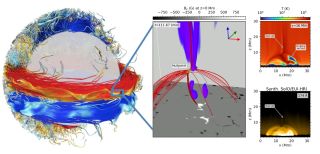Bibcode
Nóbrega-Siverio, D.; Martínez-Sykora, J.; Moreno-Insertis, F.; Carlsson, M.
Bibliographical reference
Astronomy and Astrophysics
Advertised on:
6
2020
Journal
Citations
21
Refereed citations
20
Description
Context. Ambipolar diffusion is a physical mechanism related to the drift between charged and neutral particles in a partially ionized plasma that is key to many different astrophysical systems. However, understanding its effects is challenging due to basic uncertainties concerning relevant microphysical aspects and the strong constraints it imposes on the numerical modeling.
Aims: Our aim is to introduce a numerical tool that allows us to address complex problems involving ambipolar diffusion in which, additionally, departures from ionization equilibrium are important or high resolution is needed. The primary application of this tool is for solar atmosphere calculations, but the methods and results presented here may also have a potential impact on other astrophysical systems.
Methods: We have developed a new module for the stellar atmosphere Bifrost code that improves its computational capabilities of the ambipolar diffusion term in the generalized Ohm's law. This module includes, among other things, collision terms adequate to processes in the coolest regions in the solar chromosphere. As the main feature of the module, we have implemented the super time stepping (STS) technique, which allows an important acceleration of the calculations. We have also introduced hyperdiffusion terms to guarantee the stability of the code.
Results: We show that to have an accurate value for the ambipolar diffusion coefficient in the solar atmosphere it is necessary to include as atomic elements in the equation of state not only hydrogen and helium, but also the main electron donors like sodium, silicon, and potassium. In addition, we establish a range of criteria to set up an automatic selection of the free parameters of the STS method that guarantees the best performance, optimizing the stability and speed for the ambipolar diffusion calculations. We validate the STS implementation by comparison with a self-similar analytical solution.
Aims: Our aim is to introduce a numerical tool that allows us to address complex problems involving ambipolar diffusion in which, additionally, departures from ionization equilibrium are important or high resolution is needed. The primary application of this tool is for solar atmosphere calculations, but the methods and results presented here may also have a potential impact on other astrophysical systems.
Methods: We have developed a new module for the stellar atmosphere Bifrost code that improves its computational capabilities of the ambipolar diffusion term in the generalized Ohm's law. This module includes, among other things, collision terms adequate to processes in the coolest regions in the solar chromosphere. As the main feature of the module, we have implemented the super time stepping (STS) technique, which allows an important acceleration of the calculations. We have also introduced hyperdiffusion terms to guarantee the stability of the code.
Results: We show that to have an accurate value for the ambipolar diffusion coefficient in the solar atmosphere it is necessary to include as atomic elements in the equation of state not only hydrogen and helium, but also the main electron donors like sodium, silicon, and potassium. In addition, we establish a range of criteria to set up an automatic selection of the free parameters of the STS method that guarantees the best performance, optimizing the stability and speed for the ambipolar diffusion calculations. We validate the STS implementation by comparison with a self-similar analytical solution.
Related projects

Numerical Simulation of Astrophysical Processes
Numerical simulation through complex computer codes has been a fundamental tool in physics and technology research for decades. The rapid growth of computing capabilities, coupled with significant advances in numerical mathematics, has made this branch of research accessible to medium-sized research centers, bridging the gap between theoretical and
Daniel Elías
Nóbrega Siverio

The Whole Sun Project: Untangling the complex physical mechanisms behind our eruptive star and its twins
The Sun is a magnetically active star with violent eruptions that can hit Earth´s magnetosphere and cause important perturbations in our technology-dependent society. The objective of the Whole Sun project is to tackle in a coherent way for the first time key questions in Solar Physics that involve as a whole the solar interior and the atmosphere
Fernando
Moreno Insertis